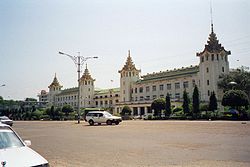Yangon Central Railway Station
| Yangon Central | |
|---|---|
| Native name ရန်ကုန် ဘူတာကြီး | |

Yangon Central railway station
|
|
| Location | Mingala Taungnyunt 11222, Yangon, Yangon Division, Myanmar |
| Coordinates | 16°46′54″N 96°9′40″E / 16.78167°N 96.16111°ECoordinates: 16°46′54″N 96°9′40″E / 16.78167°N 96.16111°E |
| Area | 5,110 m2 (55,000 sq ft) |
| Built | 1877 |
| Demolished | 1943 |
| Rebuilt | 1947-1954 |
| Architect | Hla Thwin |
| Designated | 1996 |
Yangon Central railway station (Burmese: ရန်ကုန် ဘူတာကြီး [jàɴɡòʊɴ bùdàdʑí]), located in downtown Yangon, is the largest railway station in Myanmar. It is the gateway to Myanmar Railways' 3,126-mile (5,031 km) rail network whose reach covers Upper Myanmar (Naypyidaw, Mandalay, Shwebo), upcountry (Myitkyina), Shan hills (Taunggyi, Kalaw) and the Taninthayi coast (Mawlamyine, Ye).
The station was first built in 1877 by the British but destroyed by the retreating British in 1943 from advancing Japanese forces. The current station designed in traditional Burmese architectural style, making prominent use of indigenous tiered roofs called pyatthat, was completed in 1954, designed by U Tin. Yangon Central railway station has been designated a landmark building since 1996. In December 2007, the Yangon city government announced a master plan that will relocate Yangon Central to a satellite town, East Dagon, 32 kilometres (20 mi) from downtown at an unspecified date.
The following lines pass through or terminate at Yangon Central:
Yangon Central railway station was first built in 1877 by the British to support Burma's first railway line, from Yangon to Pyay. The station was located on the southern side of the railway compound on the upper block of Phayre Street (now Pansodan Street) in the downtown area. The building was designed in the British Victorian style and the access roads were bordered by grassy lawns. The beauty of the property prompted locals to praise the new structure as the Fairy Station.
The station became a favorite target for Japanese bombers during World War II. In 1943 it was destroyed by British forces retreating to India.
...
Wikipedia

